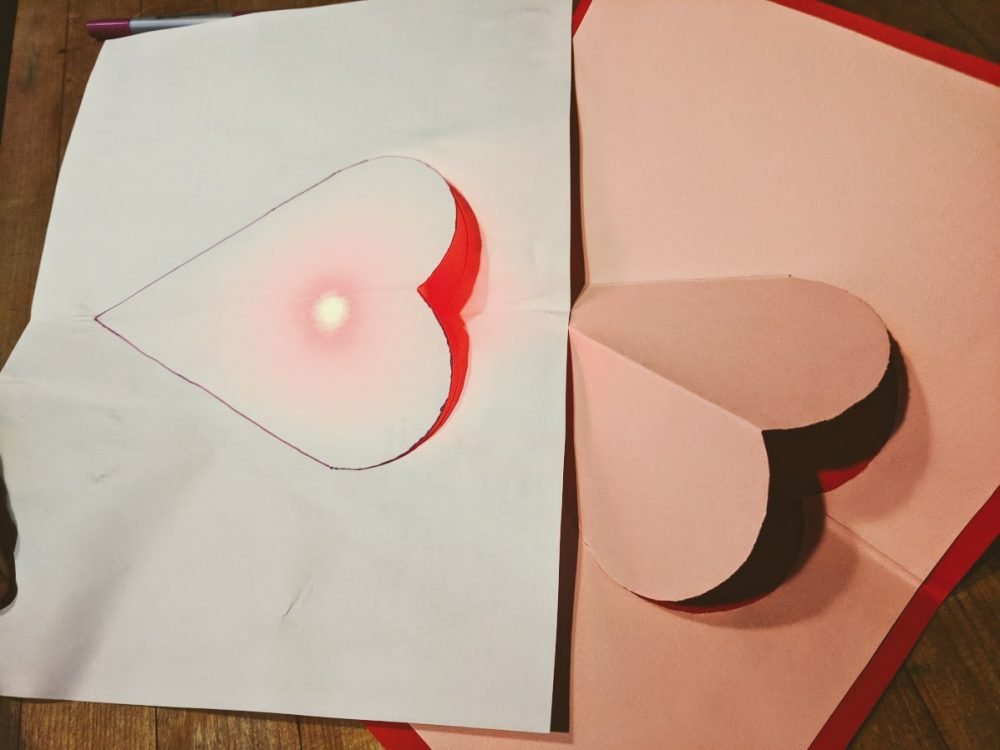 In our Valentine’s science and engineering series we thought up a few fun activities you could do that are themed towards Valentine’s day. One of these was our 3D LED popup heart cards.
In our Valentine’s science and engineering series we thought up a few fun activities you could do that are themed towards Valentine’s day. One of these was our 3D LED popup heart cards.
I love these cards because you can really scale them to be a great project for multiple aged kids or kids of varying ability levels. That means a single setup for you, and fun family time for them. It also means each individual child will have the chance to learn about popup cards as they make their own cards. Kids who have a handle on circuits can try lighting up their popup card, and kids that find that easy can try their hand at our more difficult template that produces an LED popup heart that actually beats!
In this post, we will take a look at the more mechanical side of these popup cards. Challenge your kids to see how the folds of your cards create simple mechanisms as described below!
Thrive Leads Shortcode could not be rendered, please check it in Thrive Leads Section!
Learning about the mechanisms of popup cards
Are pop up cards a simple mechanism?
Yes! A mechanism is defined as a system of parts working together in a machine. In this case the cuts and folds we make to the paper cause a heart to pop out. These folds and cuts are the systems of parts, and the machine is the animation of the card as it opens and closes.
Pop up cards and paper mechanisms.
There are a variety of ways to create pop-up cards, and the paper mechanisms of these vary. Some pop-up cards are incredibly simple, using only two cuts to fold out a box. Images and cutouts are then glued to these boxes which pop up when the card is opened. You can also glue a separate piece of paper with tabs to the card to allow it to pop up. Folding at angles and cutting on curves, as we did in the pop-up card templates above, allows you to pop out interesting shapes. You can even make pop up card mechanisms that twist as the page is opened! In fact, a great activity once you have completed our DIY pop up cards is to try and create your own 3D cards. Just cut, fold, and see what happens!
What are simple mechanisms?
We mentioned that pop up cards are a form of simple mechanism since there are parts working together in a machine. Ask your kids to think of other examples of simple mechanisms. What can they think of? Below is a list of a few simple mechanisms you can use to get their brains thinking.
Simple Mechanisms Examples:
- Lever
- Wheel
- Wedge
- Pulley
- Inclined plane
Now that you have a list, can you think of how these examples are simple mechanisms? They all change the direction or magnitude of a force, just as the pop-up card changes the direction of the force provided by your hands opening the card into a different direction allowing a piece of the card to pop up.
For example, a lever takes a force and changes its direction to be opposite. Imagine a see-saw, when your weight is pushing down the other side of the seesaw is up. When you push up the other side of the seesaw is down. You are changing the direction of your gravitational force on the other side of the lever.
A pulley, on the other hand, changes the magnitude of the force. The more pulleys you go through the larger the change is, and it is because of this that pulleys are sometimes used to lift very heavy objects. You can lift a steel beam with enough pulleys. While you might need to pull 100 feet of rope through to lift that beam only ten feet high, you are still able to lift massive objects, all because of the pully reducing the force necessary.
Check out our fun Valentine's projects!
Thrive Leads Shortcode could not be rendered, please check it in Thrive Leads Section!





2 thoughts on “Learning about SImple Mechanisms: Popup Cards”
Comments are closed.